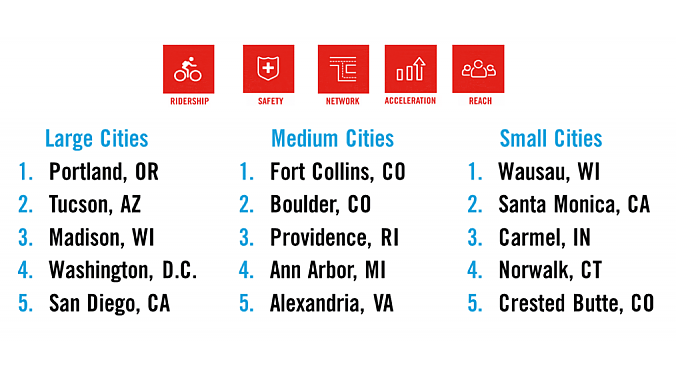INDIANAPOLIS (BRAIN) — PeopleForBikes recognized and awarded several cities at the second annual PlacesForBikes conference, which wraps up today in this Midwestern city. Through its new program, City Rankings, PeopleForBikes takes a data-driven approach to determine which cities are best for biking, and those that are improving the fastest.
At an awards ceremony held at the National Collegiate Athletic Association headquarters in downtown Indianapolis, PeopleForBikes' president, Tim Blumenthal, honored top-ranking cities and their leaders.
"We never sat around a table and said, 'Portland, Oregon, what do you think?' And then someone says, 'I was just there and it was really amazing, I think that's maybe 3.5 stars, and everyone says, yeah, that's about right'," Blumenthal told conference attendees. "It's nothing like that. You can look at the 184 calculations that go into each city rating."
The City Rankings program is based on factors including ridership, safety, network, reach and acceleration, and uses a variety of data sources to determine a city's ranking. PeopleForBikes said the City Rankings system is the first of its kind in the U.S., and that it's fully transparent and data driven, making it easy for any community to see how it's doing well and how it can improve.
Some of the data sources include:
- Street-level data from Open Street Map that includes infrastructure, traffic speed limits, where people live, how equitably infrastructure is available to disadvantaged groups and whether the low-stress bike network links people to destinations
- Local and federal data on overall traffic injury rates, for people biking and using any mode.
- The scale and variety of investment in bike infrastructure and events reported by local officials for the PlacesForBikes City Snapshot.
- The PlacesForBikes Community Survey, which asked more than 39,000 people about their riding habits and perceptions of safety and progress.
- U.S. Census Bureau American Community Survey data on the local percentage and gender split of bike commuters compared with car commuters.
- An assessment of a community's propensity to bike for fun, from Sports Marketing Surveys.
But there is a social and cultural component as well, which is more difficult to measure. Good street design is an essential ingredient, but a great biking town also has social rides, places people want to ride for fun and city officials working to make biking better — for that reason, City Rankings takes into consideration more than just infrastructure.
According to Dr. Jennifer Boldry, PeopleForBikes' research director who spent three years developing the rating system, filling in some of the gaps that some data sets like ACS and fatality data don't cover led PFB to develop the PlacesForBikes Bicycle Network Analysis, which assigns a score to the low-stress biking networks in hundreds of U.S. cities. It accounts for just under one-third of a city's rating.
"My guess is that not everybody will be absolutely thrilled about their rating. But we are grading on a global scale, and in our mind, there is no place, not even the Netherlands or Denmark that is absolutely safe, appealing and connected by bike for anyone at any age or bike-riding ability," Blumenthal said. "No place deserves a score of 100 or 5 stars. We have a lot of work to do, and we're going to do that work together."
Communities of any size can participate by completing an annual PlacesForBikes Community Survey, the PlacesForBikes City Snapshot, by actively growing riding and business in their town or city, and by working together to support implementation of complete bike infrastructure networks, among others.
See how all cities scored: cityratings.peopleforbikes.org/all-cities-ratings.
Look for more about City Rankings in the June 1 issue of Bicycle Retailer.








